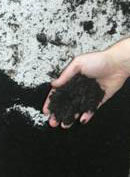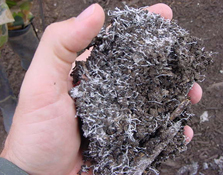Bio Active Compost
|
|
Making and applying proven, biodiverse, aerobic compost from thermal or worm (vermicompost) methods is the most effective way of improving soil health.Care must be taken to ensure the WHOLE soil food web is present and feeding in your compost. BioActive compost has high levels of beneficial microbes and when applied to your soil will improve the Soil Foodweb, and the growth of plants. At groundgocer we work continuously to distribute local, quality compost in affordable and reliable quantities. |
Groundgrocer's BioActive compost aims to transfer the minimum organism biomass for each of the different groups in the soil or compost food web to the soil. You can apply it directly to the soil around your trees or other crops, and as it’s one of the highest grade living, aerobic composts available in commercial quantities, you can also use it confidently when brewing actively aerated compost tea.
There are a number of reasons for using compost:
- To add organisms to the soil. This is not just bacteria, but fungi, protozoa, nematodes and often microarthropods. Compost serves as an inoculum of all these organisms, if the compost is made correctly.
- To add foods to feed bacteria, fungi, protozoa , nematodes and microarthropods.
- To add structure to the soil. Many composts contain physical structure components like kor (coconut fibre), clay, fibre, and chunks of wood. These impart physical structure that allows oxygen to move through the material. It is very important to maintain these air passageways into the compost.
BioActive Compost is made using thermal composting techniques as advocated by the Soil Foodweb Institute and production has been rigorously supervised to create a rich, organic, living ingredient.
Our compost is tested to the published standards of the Soil Foodweb Institute.
As Dr Elaine Ingham advocates:
| |
"Your soil needs the right biology in order to grow the plants you want, without the use of toxic chemicals. If your soil, potting mix, hydroponics medium, or compost lacks the minimum set of organisms, steps need to be taken to re-establish the right set of organisms. The compost you use needs to have the right biology. That’s the answer, the right biology. Now, if growing plants in soils where the biology isn’t right, you can get plant growth, by using the toxic chemicals to try to overcome the diseases that will attack the stressed plants, by using chemical salt inputs to try to feed the plants the inorganic nutrients they need. But the plant is not healthy, it is stressed, and the food it makes is not the best for human consumption.” |
|
Here is a an organic, scientifically tested compost that is literally crawling with life and designed to feed your soil so plants can get the organic nutrients they need.
Pictured: BioActive compost
|
Simply stated, composting is the biological decomposition of the organic constituents of wastes under controlled conditions. The term "decomposition" is used instead of "stabilization", because when applied to a practical usage, the process is rarely carried on to the point at which the waste is completely stabilized. the term "biological" distinguishes composting from other types of decomposition, such as chemical or physical. Organic is applicable because, with few exceptions, only the organic portion of wastes is subject to biological breakdown. A very important term in the definition of composting is "controlled". It is the application of control that distinguishes composting from the natural rotting, putrefaction, or other decomposition, that takes place in an open dump, a sanitary landfill, in a manure heap, or in an open field. |
Principles
Probably all of the principles involved in composting wastes can be traced to the single all-inclusive fact that composting is a biological process. Two broad inferences can be drawn from this fundamental: (1) Composting has the limitations of biological systems; and (2) The process is affected by the basic environmental conditions that influence all biological activity.
Classification
Compost systems can be classified on three general bases: oxygen usage, temperature, and technological approach. Oxygen usage is divided into aerobic and anaerobic. When temperature serves as the basis, the division becomes mesophilic and thermophilic. Finally, using technology as the key, the classification is divided into static pile or windrow, and mechanical or "enclosed" composting.
Aerobic composting involves the activity of aerobic microbes, and hence the provision of oxygen during the composting process. Aerobic composting generally is characterized by high temperatures, the absence of foul odors, and is more rapid than anaerobic composting. Anaerobic composting is characterized by low temperatures, the production of odorous intermediate products, and generally proceeds at a slower rate than does aerobic composting.
In mesophillic composting the temperatures are kept at intermediate temperatures (15 degrees to 40 degrees C.), which in most cases is the ambient temperature. Thermophillic composting is conducted at temperatures from 45 degrees C to 65 degrees C.
Essential Factors
Briefly stated, essential factors are those features of the physical, chemical, and biological background that are necessary to the establishment and proliferation of the microorganisms specific to the desired process. Five essential factors that have become key design features in recent compost technology are suitable microbial population or populations, aeration (oxygen availability), temperature, moisture content, and carbon availability.
Order your BioActive Compost online
For other quality tested soil and compost tea additives see our online shop or contact us directly on the details below.
 Australian Dollars
Australian Dollars
 US Dollars
US Dollars
 European Euros
European Euros
 New Zealand Dollars
New Zealand Dollars


